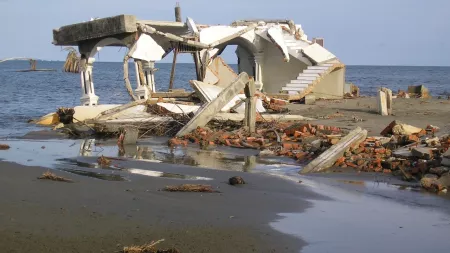Twenty years ago, the world witnessed one of the most devastating disasters in modern history. On December 26, 2004, a powerful 9.1 magnitude earthquake struck off the coast of Indonesia, triggering a massive tsunami with waves reaching up to 30 meters high, devastating millions of lives across 14 countries. The Indian Ocean Tsunami caused the loss of over 227,000 lives, with Indonesia, Sri Lanka, and Thailand among the hardest hit.
Aceh, Indonesia
Aceh, Indonesia, suffered the greatest losses, with about 170,000 lives loss. “I arrived in Aceh in mid-January 2005, and what I witnessed was beyond imagination,” said Renee Picasso Manoppo, Humanitarian and Emergency Response Manager at CARE Indonesia. “Entire buildings were flattened, fields replaced what used to be homes, and bodies were everywhere. It felt like all hope had vanished.”
Disaster preparedness is now deeply ingrained. Schools teach children how to respond to crises, and communities are better equipped to face future challenges."Renee Picasso Manoppo, Humanitarian and Emergency Response Manager at CARE Indonesia
The response to the tsunami faced immense challenges. Thousands were left homeless, communication relied solely on satellite phones, and coordinating aid was daunting, with hundreds of flights arriving daily in Banda Aceh. Despite these obstacles, CARE Indonesia delivered clean water, sanitation, housing, health services and livelihood supports to over 350,000 people in Banda Aceh, Aceh Besar and island of Simeulue, paving the way for long-term recovery. The tsunami-related program concluded in 2009, leaving a lasting impact on the regions. “Today, Banda Aceh especially, has come a long way,” reflected Renee. “Disaster preparedness is now deeply ingrained. Schools teach children how to respond to crises, and communities are better equipped to face future challenges.”
Mullaitivu, Sri Lanka
In Sri Lanka, the tsunami claimed 30,500 lives and left widespread destruction. Mullaitivu, a coastal region, was among the worst affected. “When the sea pulled back, we thought it was drying up, not knowing what was coming. My father-in-law saved my son and me by holding onto a tree, but he lost his life to the waves.” said Vasthiampillai Jeyarani, a survivor. She is one of many whom CARE worked with to rebuild home and supported long-term recovery in her community.
Today, women in Northern Sri Lanka are at the forefront of rebuilding efforts.
Beyond immediate relief, a district-level Disaster Management Center was established to prepare for future crises. This has become vital during Cyclone Fengal, when early warnings saved lives and property.
Today, women in Northern Sri Lanka are at the forefront of rebuilding efforts. Many have started small businesses, such as food production and handicrafts, helping to support their families and boost the local economy.
Andaman coast, Thailand
In Thailand, the tsunami claimed over 5,000 lives, devastating the Andaman coast, a popular tourist destination. While much of the media attention during the tsunami focused on international tourists visiting Thailand during the holiday season, local fishing families faced the lasting impact. Over 500 fishing boats, ten trawlers, and essential infrastructure were destroyed, leaving many without homes or livelihoods.
The principle was simple - provide cash directly to affected people instead of preselected relief items"Promboon Panitchpakdi, Executive Director of Raks Thai Foundation
Raks Thai Foundation (CARE Thailand) focused on non-tourist areas such as Krabi, northern Phang Nga, and Ranong, where aid was limited, to support vulnerable communities, including the Moken; an indigenous community, and migrant workers. To avoid duplication and inefficiencies in relief efforts, the team introduced community-owned revolving funds. “The principle was simple - provide cash directly to affected people instead of preselected relief items,” said Promboon Panitchpakdi, Executive Director of Raks Thai Foundation. Communities managed the funds, setting repayment terms to ensure sustainability.
For the Moken, an indigenous seafaring community, these funds were transformative, allowing them to repair boats and restore their traditional seafaring way of life. The initiative supported immediate recovery and laid the foundation for long-term resilience.
20 years after Indian Ocean Tsunami
“As we mark 20 years since the devastating Indian Ocean tsunami, we reflect on a tragedy that changed the global humanitarian landscape. The 2004 tsunami was a turning point not just for CARE, but for the entire humanitarian community. It taught us the importance of coordination and the resilience of the human spirit. Today, we face increasingly frequent and complex crises, worsened by climate change, which disproportionately affect the poorest and most vulnerable, especially women and girls.
At CARE, we have learned that addressing humanitarian crises demands more than immediate relief. It necessitates supporting recovery, building resilience, and proactively preparing for future shocks. We are committed to community-led early warning systems, disaster preparedness, and livelihood protection. As challenges grow, so does our resolve to help those most affected by climate change to adapt and thrive,” ended Ramesh Singh, Asia Regional Director.
For media enquiries, please contact:
Sarita Suwannarat, Asia Regional Communications Advisor
Email: [email protected]
